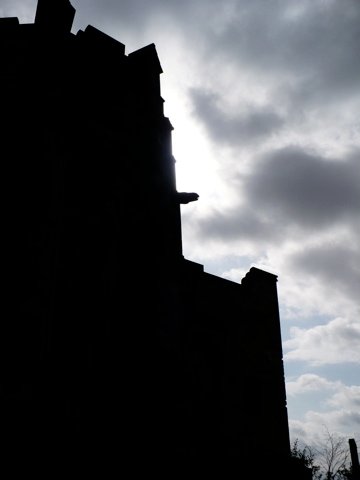
I’m now covering my last few days in the UK, which I mostly spent in Edinburgh. It’s a lovely city, but I’m sorry to say that I didn’t warm to it as much as I thought I would. That may have had something to do with inflated expectations (everybody I know who’s been there raves about the place), and it may have had something to do with the fact that my summer wardrobe was no longer adequate in this more northerly clime, in early autumn. But I think it was mostly because, having come direct from Hadrian’s Wall, I was now really impatient to get to Rome and see it for myself. Once I managed to put Edinburgh’s position in my itinerary to one side, I did really enjoy it for itself.
Above: the Scottish National War Memorial (see below). Yet again I go for the easy silhouette effect.
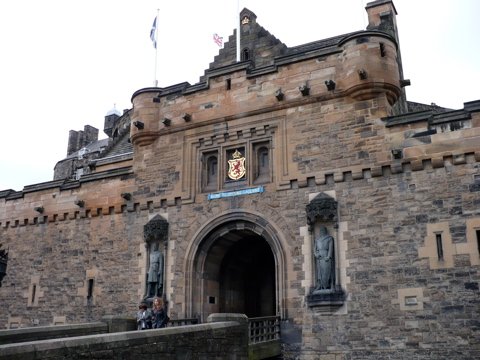
My first objective after hitting town (after finding my hotel and dumping my bags) was Edinburgh Castle. The gatehouse, seen above, dates all the way back to 1888!

Well, I didn’t come here to see some Victorian fantasy castle. Luckily, it gets better inside. Beyond the gatehouse is this sheer cliff face and wall, surmounted by the 16th-century Half-Moon Battery, lined with gun-ports.
Wait … gun-ports? For cannon? In a castle? Not arrow loops for archers and crossbowmen? Well, yes. I honestly was a bit surprised to see so many cannon about. But, of course, castles that were in use up in the gunpowder era had to have up-to-date weapons.
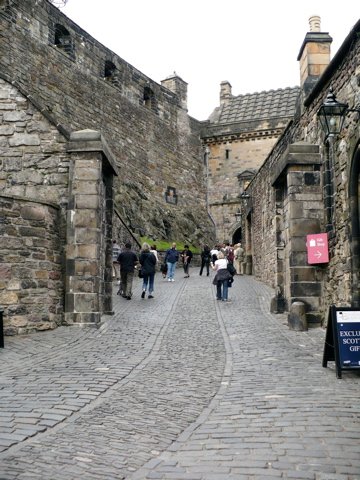
This road along the base of the Half-Moon Battery, leading into the 16th-century portcullis beyond, looks quite defensible. And it is. The longest siege endured by the castle lasted over a year, in 1571-3: the Lang Siege. Forces loyal to Mary, Queen of Scots held the castle against Regent Morton’s army, and were only defeated when the latter rather unsportingly called in heavy siege cannon from the English. These destroyed the huge David’s Tower, which stood where the Half-Moon battery is today. In fact, much of the castle’s architecture dates to the rebuilding after the Lang Siege or later.
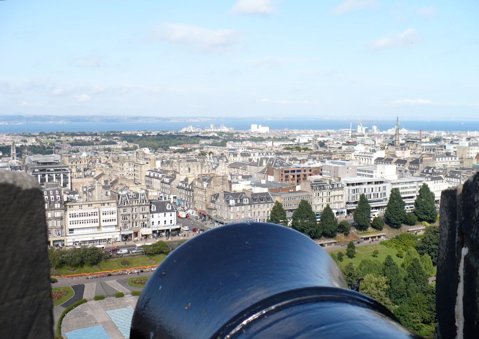
Looking northish over the battlements, towards the port of Leith, on the Firth of Forth. As you can see, the castle has a (I suppose, literally) commanding view of the city: a cannonball fired from up here would land in amongst all those houses.
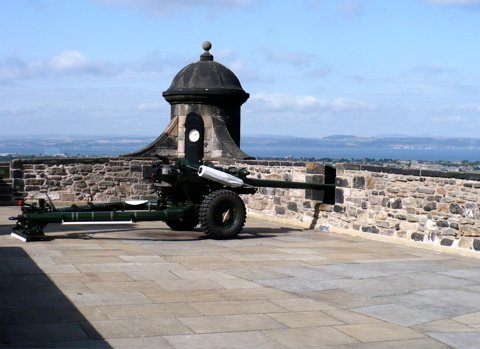
Unlike all the others, this cannon is in working condition; in fact, it’s used every day. It only fires blanks though — it’s the One O’clock Gun. I’m not sure where I was at 1pm on the days I was in Edinburgh, but I never did get to hear it.

This bit looks particularly castlelike, though it’s apparently just a water cistern. (It’s in the Crown Court, on the left is the bookshop, on the right is Foog’s Gate.)

The little building on the left is St Margaret’s Chapel, the oldest building in the castle. It was built early in the 12th century, probably by the future David I.
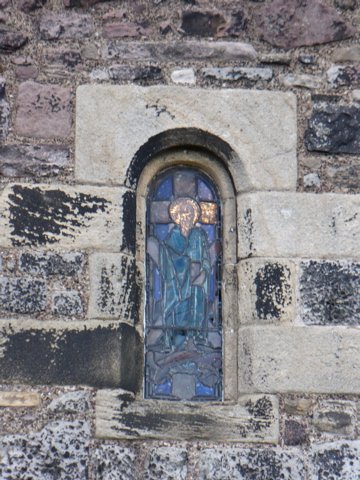
One of the chapel’s tiny stained glass windows (from a relatively recent restoration). What they saved on stained glass they probably lost on candles, summed over the centuries.

From the other side, inside the chapel. From the 16th century, it was used as a gunpowder store — it’s lucky to have survived!
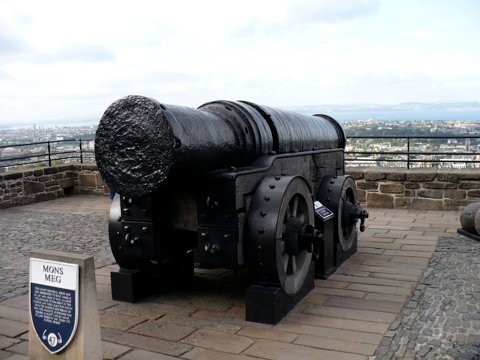
Now this is a cannon: Mons Meg, 6 tons of spitting iron. With a caliber is 22 inches, it fired 180 kg of shot at a time over a distance of two miles (at least, from up here it would). Meg’s early history is a bit obscure but it was made in the mid-15th century in Hainaut, then part of the Duke of Burgundy’s lands. Whether it was ever actually used in battle or siege doesn’t seem very clear. The last time it was fired, in 1681, the barrel burst and it was unceremoniously dumped outside Foog’s Gate, where it lay for a seventy years until somebody took it away to the Tower of London.
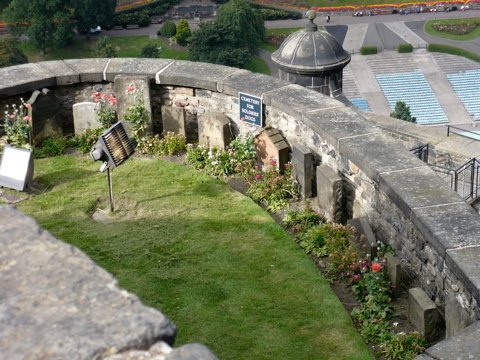
I’m not a dog person, but I found this very touching: a 19th-century cemetery for soldiers’ dogs.
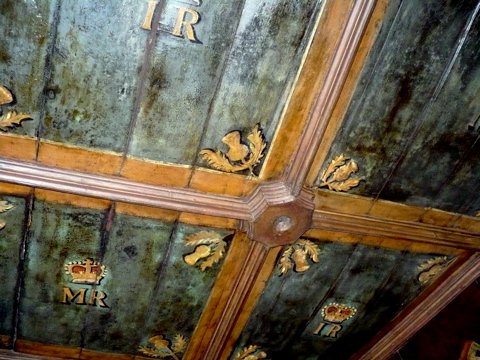
The ceiling of the bedchamber in the Royal Palace where Mary, Queen of Scots, gave birth to James VI and I (actually, I think he was born in a tiny room to one side). Note the thistles, and the inscriptions MR and IR (Maria Regina and Iacobus Rex, I assume). The view of the city from here is stunning. The palace also contains, among other things, the Stone of Destiny, which sounds like something out of a cheap Tolkien knock-off but is actually a rather important historical object; and a fascinating exhibition about the prisoners kept here over the centuries. I had no idea that American sailors captured during the War of Independence were brought here, for example.
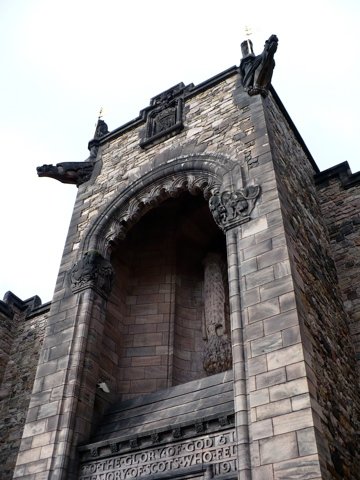
I have noted here before that the Imperial War Museum didn’t really impress me as a war memorial — not as much as the Shrine of Remembrance or the Australian War Memorial. For that matter, I don’t think at any of the major memorials I saw in London (the Cenotaph, for example) were as impressive as the ones back home. (Which is not at all to say they weren’t moving, but I’m a peasant, I suppose — I think big things are cool.) But the Scottish National War Memorial is much more like it. It’s imposing and sombre, and sits at the top of Castle Rock in the heart of the castle and of the city. It commemorates 206,284 Scots who fell in the wars of the twentieth century.

Like the IWM, it’s adapted from an existing building, in this case an 18th century barracks. Which I didn’t actually realise when I was there. But the whole thing works for me. (Plus it has gargoyles!)

The National War Museum also resides within the castle (along with a couple of regimental museums), and is definitely worth a visit. Here’s a gas mask for a baby from 1939: note the bellows at the side, for pumping air in so the baby can breathe; compare with the one shown here. (Also note the Protect and Survive pamphlet.)
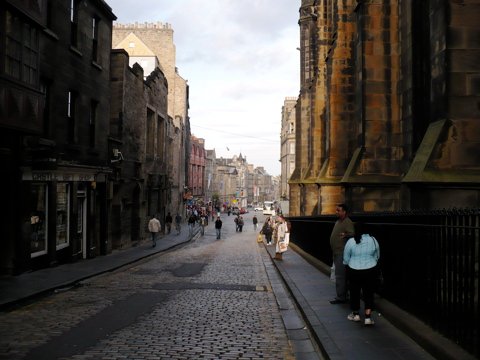
Descending from the mount through the Old Town, along the famous Royal Mile. (Though, now that I think about it, I don’t think I actually walked the whole mile. I’ll have to go back.)

When is a police box not a TARDIS? When it’s in Edinburgh.

The Lothian Chambers, on George IV Bridge. Not of any great historical significance, but I like the way it gleams in the sun.
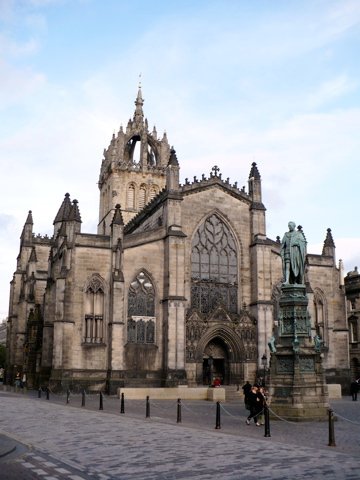
St Giles’ Cathedral, the High Kirk of Edinburgh. (The Tron Kirk has a way cooler name, though.) The statue is of the 5th Duke of Buccleuch, who was the grandfather of the 2nd Baron Montagu of Beaulieu, one of the earliest British airpower theorists and whose archives I looked at in London.

Where York has its snickelways, Edinburgh has closes, which run down the steep sides of the mount, with high tenements on either side. This is Advocate’s Close.

I don’t know how safe Edinburgh is at night (though the area I was staying in did get a bit lively), but you wouldn’t catch me walking down there after dark …
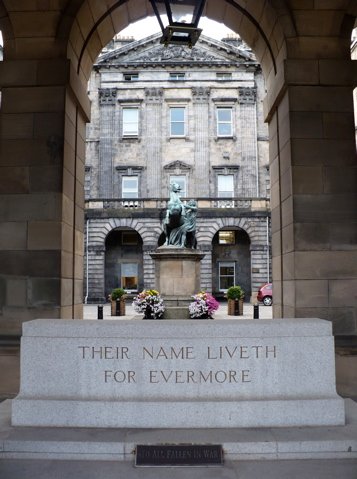
I’ll end with two more war memorials. Here’s the Stone of Remembrance in front of the City Chambers. (The statue behind is Alexander taming Bucephalus. Why, I have no idea.) Oddly, it doesn’t seem to be listed in the UK National Inventory of War Memorials, or if it is, it’s well hidden.
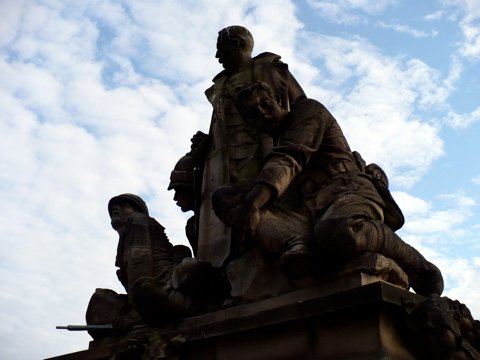
This, on the South Bridge, is the King’s Own Scottish Borderers Memorial. Unlike the Scottish National War Memorial and the Stone of Remembrance, which are from the post-First World War period, this was unveiled in 1906 and commemorates the KOSB’s sacrifices in campaigns from Afghanistan to South Africa.
![]() This work is licensed under a Creative Commons Attribution-NonCommercial-NoDerivatives 4.0 International License.
Permissions beyond the scope of this license may be available at http://airminded.org/copyright/.
This work is licensed under a Creative Commons Attribution-NonCommercial-NoDerivatives 4.0 International License.
Permissions beyond the scope of this license may be available at http://airminded.org/copyright/.



Stunning photos, Brett! Isn’t the light wonderful? You’ve invoked a very rare flash of homesickness in me by making the place look so lovely. But don’t worry – I won’t fight a rear-guard action to extol the virtues of Edinburgh. Unfortunately it can be, like many parts of Scotland, slightly chilly, in terms of both climate and welcome (but not violent in the centre of the town, which is why students can happily stagger around the closes late at night). I’d probably be itching to get on to Rome if I knew that was next on my agenda. But I’m glad you got to Auld Reekie and found the castle, etc interesting.
I hope someone taught you how to pronounce Buccleuch? I used to live in Buccleuch Street in Edinburgh. What a delight that was every time I had to give my address over the phone. I used to get credit card bills addressed to ‘Buckloo Street, Edimbrough’. (Sent from Croydon, or some similarly non-exotically named place….)
I didn’t really mind the chilliness, it was after all only the merest hint of winter’s first breath, and was to be expected at that time of year. And it did stay fine enough to be out and about and taking photos. I’m glad you think I did Edinburgh justice — and yes, there’s something special about the light. It’s so much softer than the light here in Australia, where the Sun is always beating down from high overhead. But it’s also the altitude and the air, I suppose. Anyway, I’d love to go back one day, just not immediately before Rome!
Actually, no I didn’t know that’s how you pronounce Buccleuch — luckily it never came up in a social situation or I would have been dreadfully embarrassed! Maybe you can help me with another aristocratic Scottish name: how would you pronounce Haldane? I was surprised the other day to hear somebody refer to J. B. S. Hawl-dane, which I might have just assumed was just received pronunciation, except that it was prefaced by his telling that as a child his family stayed with Naomi Mitchison (J. B. S.’s younger sister) at her home in Kintyre. So maybe that’s how I should be saying it instead of my Aussie-inflected, short, Hal-dane.
Interesting one. I would say Hal-dane, and that’s how I’ve usually heard it pronounced. Pronunciations such as ‘Hawl-dane’ do always grate as excrutiatingly pretentious RP affectations (I react in the same way to ‘Raif’ for Ralph, and even ‘Leftenant’. It’s a genetic/socialized reflex. I can’t help it.) But Hawl-dance may, in fact, be ‘correct’, ‘even’ in a Scottish accent.
After all, Sir Alec Douglas- was, indeed, ‘Hume’, even though he was Home. Likewise, the most popular chain of newsagents in Scotland for decades was called ‘John Menzies’. The entire population south of Perth (Scotland!) pronounced this as it is written (as I think you Aussies did with your former PM?) Only when Sir Ming became leader of the Lib Dems did we all accept that it should, in fact, be pronounced ‘Ming-is’. Prior to Ming, that pronunciation was considered rather affected.
Then there is the distinguished Professor Hugh Strachan. I simply cannot make myself pronounce that as ‘Strawn’. It may well be ‘correct’, but to me, and 99% of Scots, it is ‘Strachan’ – using our famous guttural ‘ch’, as in ‘loch’ (which the English are incapable of distinguishing from ‘lock’. And which is a sound they struggle to master when they try to learn Spanish). Likewise, there is your national hero ‘Glenn McGra’. No-one in Scotland would miss out the ‘-ath’, and we get very annoyed indeed when the BBC choose to adopt these types of (mis-)pronunciations.
But who is truly ‘correct’ on these ones, in either historical or phonetical terms, I can’t say with accuracy. Many are genuinely debatable. Victoria Wood summed this all up beautifully when she quipped that everywhere in Scotland seems to be ‘spellled Kircudbright but pronounced Eccelfachan’.
I do know, however, that Kircudbright is definitely ‘Kircoodbry’ and Culzean is ‘Cul-lane’. And, as I often wanted to scream down the phone, ‘Buccleuch rhymes with **** you!’
Totally agree with ‘Raif’, but ‘leftenant’ is part of the never-ending struggle against the Americanisation of English!
With Menzies, I’m sorry to report that he was about the only person who pronounced his surname that way, being proud of his Scottish ancestry — at least in my lifetime it’s always been said the way it’s spelled. But it is the reason why he was often called by his nickname, Ming (except, that is, when he was called ‘Pig-iron Bob’ for his role in forcing striking dockworkers to load scrap iron onto ships bound for Japan. In 1938, mind you …) Of course I always thought this came from Flash Gordon (as he was sometimes called Ming the Merciless too). It’s all good …
McGrath and Strachan (there was a well known Strachan here too, a glam rocker from the ’70s — pronounced Strawn too) are a bit odd — naively I’d expect mispronunciations to be more phonetic, not less. McGrath I suppose is less odd, the -th wouldn’t be too hard to lose (plus ‘ooh, ahh, Glenn McGraTH’ just doesn’t work), but how did we get from Strachan to Strawn? I blame the Cholmondeley-Featherstonehaughs.
OK, another question: if Culzean is pronounced Cullane, how would you say ‘Tarrinzean’? ‘Ta-rain’?
You Scots are well confusing. OTOH, I grew up in a part of Hertford (pr: ‘artford) called Bengeo (pr Ben-jee-oh) and now I live in Leicester (pr Lester) so who are we English to take the piss?
Mmm…you’ve got me on that one. How do you pronounce ‘Tarrinzean’? I know ‘Mauchline’ is ‘Moch-lin’ (like loch, again).
I completely agree that ‘leftenant’ is an important (and correct) one, but the irony is that it has now come to be rather lumped-in with ‘Raif’ et al. However, high Tory Scottish aristos do use a pronunciation register which genuinely differs from the majority of Scots, and always has done – see ‘Hume’ for ‘Home’. Hence their pronunciations of some names may genuinely be the correct ones, not ‘affectations’.
It is all socio-linguistics, of course. Perceptions change over time. Ming Campbell’s greatest achievement may prove to be that he brought the ancient ‘z=ng’ pronunciation back into everyday use. Because he is generally well-liked north of the border, everyone dropped their fear of seeming ‘pretentious’. Even the English learned a new phonetic sound! Some slogans and headlines praising Ming while criticizing ‘Flash Gordon’ (Brown) also helped. (Although I don’t think even Brown’s biggest fans would call him ‘Flash’ these days…)
I’m sure Mel Gibson wrestled with all of this when he rekindled our desire for ‘freedom’. Perhaps Shir Shean Connery, the ‘greatest living Scotsman’, gave him some vocal coaching. But if McGrath ever brought the derided Imperial game of glorified Rounders to Scotland the crowds would simply adapt. They would, doubtless, chant ‘ooth, aath, Glenn McGrath’!
Ha, yes, Mauchline is the other one to go with Tarrinzean (family connection) though I foolishly supposed it would be straightforward. It’s all so confusing — it’s easier just to bulldoze through unashamedly in my Australian accent, I think, perhaps exaggerated for effect.
And why the scare quotes around ‘greatest living Scotsman’? Surely there can be none other! He’s been in at least three films involving airships, after all.
“game of glorified Rounders” – I didn’t realise Glenn McGrath played baseball!
While on strange variants of the English tongue, how about Aberdeen, where “wh” becomes “f”, as in “Fit like, ma loon” (Tr. “How’s it going, old chap”)
Only really boring people say “You went to abc and didn’t see xyz!”, so may I recommend the Royal Museum of Scotland and the Museum of Flight at East Fortune for your next visit. The former has several galeries devoted to technology and a wonderful Victorian cast iron with glass entrance hall. East Fortune was the starting point for R34’s return crossing of the Atlantic; there’s a memorial, and a few bits of airship, plus lots of other aeronautica.
Thanks, Ian — I did actually go to the Royal Museum, and saw the Weir autogyro among other things. (There’ll be a photo in Edinburgh 2.) I’ll put the Museum of Flight on the list for next time!
Pingback: Airminded · Edinburgh 2
Hi Brett,
Could we have your permission to reproduce the image of the Stone of Remembrance in Edinburgh in our autumn edition of the Army Families Journal (a free quarterly magazine for the families of British soldiers). If so, could you send it to me in high resolution please? And would we credit it to ‘Brett Holman’?
Thanks!
Sure, no problem, I don’t mind use in not-for-profit publications.
Is their a British term during WW II of ‘Leftenant’?
thank you.
MK
Sorry, I’m not sure what you are asking. But “leftenant” is how the British Army (and Commonwealth armies) pronounces “lieutenant”. I’ve heard that the Royal Navy (and presumably Commonwealth navies) say it something more like the American way, but couldn’t say for sure.
Chris, if you were really brought up in Bengeo, you’d know it’s pronounced “Ben-jo”.
No, there’s the last remnant of a swallowed ‘e’ in there as well.
Magdalen College, Oxford, is of course pronounced ‘Maudlen’. The river Cherwell runs through its grounds. In Oxfordshire north of the city Cherwell is pronounced phonetically, but in Oxford it becomes the ‘Charwell’.
Within Oxford the river Thames is known as the Isis. However, in the city it is spelt ‘Isis’ and pronounced ‘Isis’, rather than spelt ‘Thames’ and pronounced ‘Isis’. I can’t imagine why. Leads to an awful lot of confusion.
“I can’t imagine why.”
For the same reason as all the other examples – to separate ‘those in the know of group A’ from ‘everybody else’. It’s so pervasive you find yourself tempted to take it seriously. There were a lot of things I enjoyed about living in Oxford (and the UK) but this kind of parochial elitism wasn’t one of them.
I blame the Cholmondeley-Featherstonehaugh family, or possibly the Beauchamp-Mainwaring-St Johns.